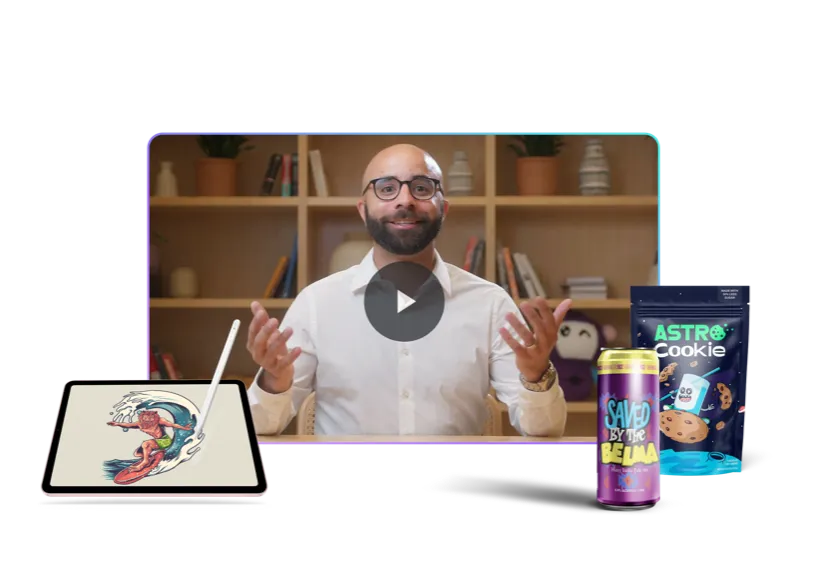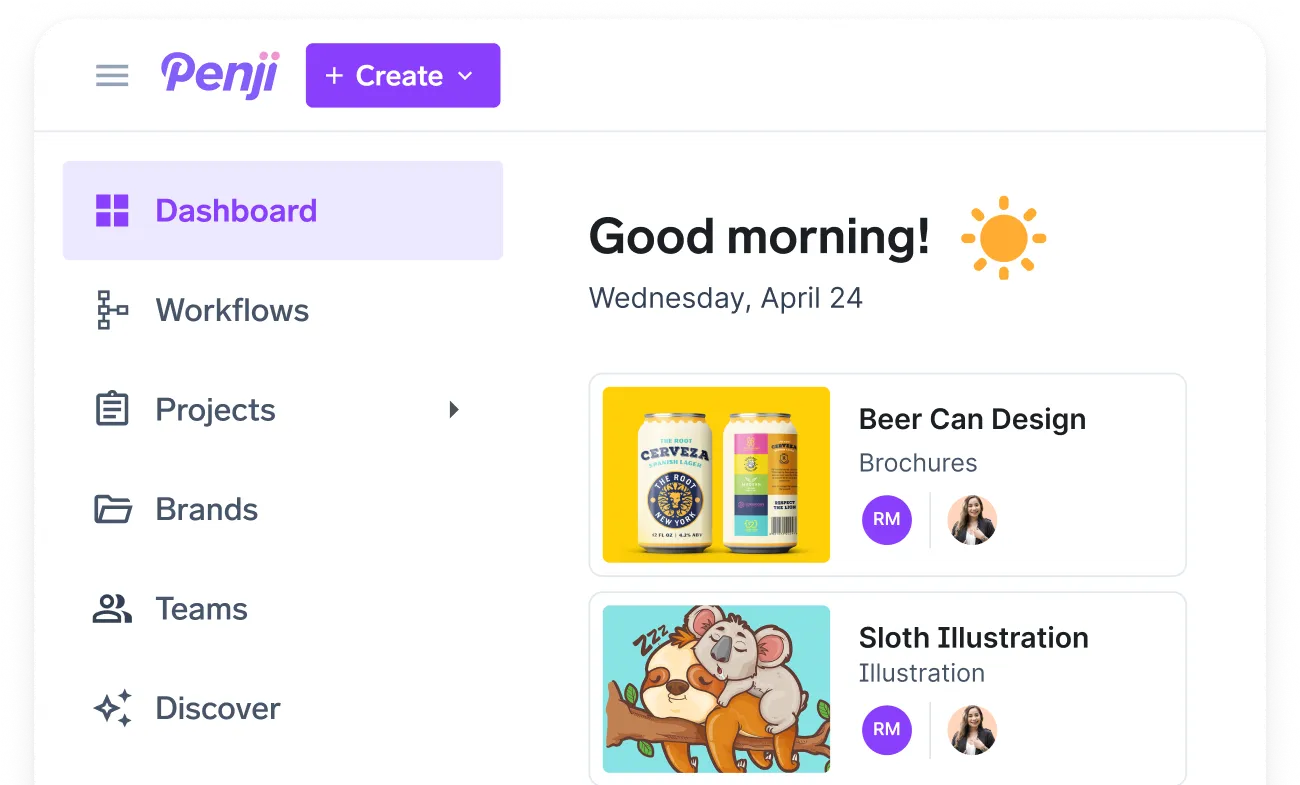![[Fully Managed] Kevin Ingalls from Boostlabs Ep. 220](https://penji.co/wp-content/uploads/2025/08/BLOG-IMAGE-Kevin-Ingalls.jpg)
Introduction
Shannon Donnelly (SD): Hello, everyone, and welcome to the Fully Managed Podcast. Kevin, thank you so much for joining me today. I really appreciate it.
Kevin Ingalls (KI): My pleasure. Thanks for having me.
SD: Thank you. So for everyone that is in the audience right now, Kevin has a lot of design experience. So I thought I’d throw you a game that would be very fun. I hope that you’ll enjoy it. It might be something that you’ve never really thought about before. It might be something that you think about all the time. I’m not a designer, so I don’t have the designer brain, but this might be fun. So are you ready?
KI: I guess so.
SD: So this game is called Old or Gold. I’m going to give you a list of brands that have had their logo for a pretty long time. Maybe it’s varied slightly. I’m not positive of the history of every single one of these, but I want you to tell me whether you think that it should stay the way it is or if you would change it and how you would change it. Obviously, you can’t show me, which is probably a big part of it, but you can describe it to me. Does that sound good?
KI: Hey, let’s do it. I have not been in the branding game for many decades, but yeah, this is something that would be fun to do.
SD: Yeah. It’s like a fun little exercise. Maybe your creative juices will be flowing and you’ll be on your game today.
Verizon
SD: All right. So the first one is Verizon.
KI: Yes. The Verizon logo, mainly being the center face of the brand, is very recognizable. The big check mark, the V—I don’t know if they’ve gone through a rebrand in the last five or so years, but to me that brand has always been pretty modern. It’s brightly colored. It feels like it’s from the 2020s. I would say that one’s pretty golden for me. Of course, as a designer, I can always find improvements in anything. I often joke that the trash can has existed for a million years and yet we can still design new trash cans every year. So yes, we could design a new Verizon logo, but I consider that one golden.
SD: I would agree. I think it’s pretty notable. I think all of these are pretty notable, though, just because they’re notable brands. So it really depends on your perspective.
Yahoo
SD: So the next one is Yahoo.
KI: Oh my gosh. I think it’s maybe changed once. As far as I’m aware, it’s not very… yeah, I’m going to be in trouble for this one. I actually used Yahoo as an example of a poor user experience and poor brand experience in a social media post I did recently. I’m going to have to call that one in need of work.
SD: What would you do to it personally?
KI: Well, I’m a big believer in Hick’s law—keep things as simple as possible. The reason that the Travelers logo, the FedEx logo, or the Verizon logo work is because they keep it simple. They don’t try to say too much with their logo. They focus on one core belief about their brand because that’s all people can take. It ties in with cognition; we don’t want to be overloaded. So I would simplify that logo quite a bit and focus on what differentiates Yahoo.
SD: I completely agree. I think I even have trouble picturing the logo right now. I know that it’s purple and has an exclamation mark. I’m thinking of just the Y. I use Yahoo email regularly and I don’t even think of the logo. That’s probably not great.
KI: Yeah, that one feels like maybe they gave it to a nephew or cousin to do and just didn’t veer too far from it.
SD: Yep, for sure. I think everyone has critiques for Yahoo—whether design-wise or that they could have stayed ahead with email. So you’re not the first to point it out.
Gap
SD: The next one would be Gap. This one I know recently altered their logo and people got upset and they put it back.
KI: Oh, I hadn’t heard that. They put it back?
SD: Yeah, which I thought was interesting because normally that’s not really… I’m sure it happens, but it’s rare.
KI: That may have been strategic marketing because nobody does that. It could drive interest and talk about the brand. In general, I’m aware of the Gap logo. It’s very familiar and simple. It follows all my checklist items. I’d call that one golden.
SD: Is there any time where simplicity isn’t best for a logo, or is that your rule of thumb?
KI: It’s my rule of thumb, but if your brand’s core message is counter to simplicity—like Salt Life, which is grungy and ocean-going—simplicity doesn’t make sense. You want visual interest there.
SD: That makes sense. Simplicity works when it aligns with what the brand stands for, but you want to stand out without overwhelming people.
KI: Absolutely. Since the late ’60s, there’s been strength in simplicity. I don’t see us going back to chaotic, hand-drawn logos of the early ’60s.
Walmart
SD: I recently discovered that the Walmart logo used to be old-timey Western when it came out. I love that. I wish they kept it. I think it’s cooler than the current blue and yellow. But that’s more complicated—the new one is simplistic. And I know the little… I don’t know what to call them, the little “boop” above, is very identifiable.
KI: I would say it wouldn’t work for everybody to go back to high-character crests or hand-drawn script logos of the ’60s. But you make a good point—you do want to differentiate, and for a brand here and there, it can work.
Unique Project Approaches
SD: Could you share a project where a unique approach gave unexpected outcomes?
KI: Sure. We started our business in 2009, during exponential growth in data—but not in visualizing it or making use of it. We wanted to help companies monetize this growing data. For example, we worked with a marketing company that sells online cookie data to advertisers. They could target left-leaning audiences by advertising on The Daily Show, for instance. This was complicated data—no human could fully understand all the inferences. We built their data visually from the ground up so everyone at the company understood it. From there, we productized several tools to help customers target ads effectively.
SD: That’s interesting because back in 2009, this was overtly complicated and new. Now it’s more common. But having that data-driven approach early on must have been a learning experience.
KI: Absolutely. It takes a team. Our niche is blending left-brain analytical thinking with right-brain design. You need both to pull insights from complicated data.
Storytelling with Data
SD: How do you balance storytelling—which is huge in marketing—with the science of data visualization to engage diverse audiences?
KI: Stories are the best way to reach people. They work in sales, entertainment—everywhere. For us, the story comes from the data. For that marketing company, we showed the “family tree” of their 70 categories and 160–170 subcategories of data using a sunburst diagram. It revealed how everything branched and connected. We reduced it to 40 logical categories with a clear taxonomy, making sales and product development easier.
SD: So you use data to tell the story rather than tacking it on afterward?
KI: Exactly. We unearth the story from the data, rather than scripting a story and finding data to fit.Walmart
SD: I recently discovered that the Walmart logo used to be old-timey Western when it came out. I love that. I wish they kept it. I think it’s cooler than the current blue and yellow. But that’s more complicated—the new one is simplistic. And I know the little… I don’t know what to call them, the little “boop” above, is very identifiable.
KI: I would say it wouldn’t work for everybody to go back to high-character crests or hand-drawn script logos of the ’60s. But you make a good point—you do want to differentiate, and for a brand here and there, it can work.
Unique Project Approaches
SD: Could you share a project where a unique approach gave unexpected outcomes?
KI: Sure. We started our business in 2009, during exponential growth in data—but not in visualizing it or making use of it. We wanted to help companies monetize this growing data. For example, we worked with a marketing company that sells online cookie data to advertisers. They could target left-leaning audiences by advertising on The Daily Show, for instance. This was complicated data—no human could fully understand all the inferences. We built their data visually from the ground up so everyone at the company understood it. From there, we productized several tools to help customers target ads effectively.
SD: That’s interesting because back in 2009, this was overtly complicated and new. Now it’s more common. But having that data-driven approach early on must have been a learning experience.
KI: Absolutely. It takes a team. Our niche is blending left-brain analytical thinking with right-brain design. You need both to pull insights from complicated data.
Storytelling with Data
SD: How do you balance storytelling—which is huge in marketing—with the science of data visualization to engage diverse audiences?
KI: Stories are the best way to reach people. They work in sales, entertainment—everywhere. For us, the story comes from the data. For that marketing company, we showed the “family tree” of their 70 categories and 160–170 subcategories of data using a sunburst diagram. It revealed how everything branched and connected. We reduced it to 40 logical categories with a clear taxonomy, making sales and product development easier.
SD: So you use data to tell the story rather than tacking it on afterward?
KI: Exactly. We unearth the story from the data, rather than scripting a story and finding data to fit.
Audience Approaches
SD: I think that’s much more convincing for a larger audience than emotional anecdotes.
KI: Any data can support what humans want—more happiness and less pain. If you can unearth data showing how your audience can be happier or avoid pain, you have a marketing story.
SD: I agree. If data supports making life easier or healthier, that’s powerful. Some people don’t want too much data, but it can be implemented in a way that’s easy to understand.
KI: True. Anecdotes are powerful, but some people dig deeper. If your claims aren’t backed up by evidence, they’ll find out—and so will others.
SD: And they’ll broadcast it. I think anecdotes might lose value because there’s so much noise. I see dozens of ads for the same type of product, all with personal stories, but I trust hard numbers more. I want to see studies, results, and credible researchers.
KI: I’d like to think so, but I’ve been frustrated by the reduction in evidence in ads. I try to debunk false claims and call out “snake oil,” but it feels like a losing battle.
SD: I try to be optimistic. But with social media, people are more easily persuaded. The hope is that bad experiences will make people think more critically, but I’m not sure it will happen.
KI: I have young kids, and I’ve learned they need to experience pain to learn. Cognitive studies talk about “level one” thinking—entertainment mode, like scrolling on social media—and “level two” thinking, where you’re deeply engaged, like in a classroom doing complex work. Level one is easy to manipulate; level two challenges information. Unfortunately, we’re getting less level two in our lives.
AI in Design
SD: I also think AI reduces level two thinking. When I was in college, I had to research and write essays without AI. Now, tools can do that for you. It’s helpful, but maybe harmful for critical thinking. But AI can still enhance design workflows. How do you integrate it into your process?
KI: You’re right—if you’ve learned the skill first, AI becomes a tool to make you more efficient, not a crutch. We use AI daily: to write contracts, create product roadmaps, summarize meeting notes, and brainstorm designs. Tools like Canva, Figma, and FigJam, plus plugins, help us draft UI/UX concepts our team can refine. At this stage, AI isn’t a designer or developer, but it’s great for brainstorming and rough drafts.
SD: I agree. It’s best for starting points, inspiration, or tedious tasks. It’s like computers when they first came out—people resisted, but now they’re essential.
KI: Exactly. I still pull inspiration from design books and posters, but large language models are now a strong source of ideas.
Originality and Criticism
SD: Have you read The Art of Stealing? I think of it when I think of AI inspiration. No one has purely original thoughts—we all pull from somewhere, even subconsciously. The key is using inspiration tastefully.
KI: I agree. Seasoned designers accept that ideas flow from life experiences and influences. Once you accept that, you stop being overly attached to your ideas and can handle criticism better.
SD: That’s true. People take criticism personally because they feel ownership over an idea. But in reality, most ideas are built from previous ones. Innovation often means improving something that already exists.
KI: Yes—many successful ideas combine two things that weren’t together before. It’s about creating fresh combinations, whether in business, art, or even fusion cuisine.
Closing Remarks
SD: It might not be purely original, but if it feels fresh, that’s artistic. We’ve had a lot of philosophical conversations today instead of technical ones—but I enjoyed it.
KI: Same here. It was great to meet you, Shannon. I love what you’re doing at Penji, and I hope your audience checks out Boost Labs.
SD: Thank you. Everything for that will be in the description, so you can check out Boost Labs and Kevin’s work. Thank you and have a lovely day, everyone.
KI: Thanks. Bye.
https://www.linkedin.com/in/kevingalls









